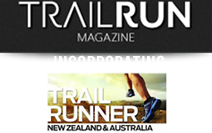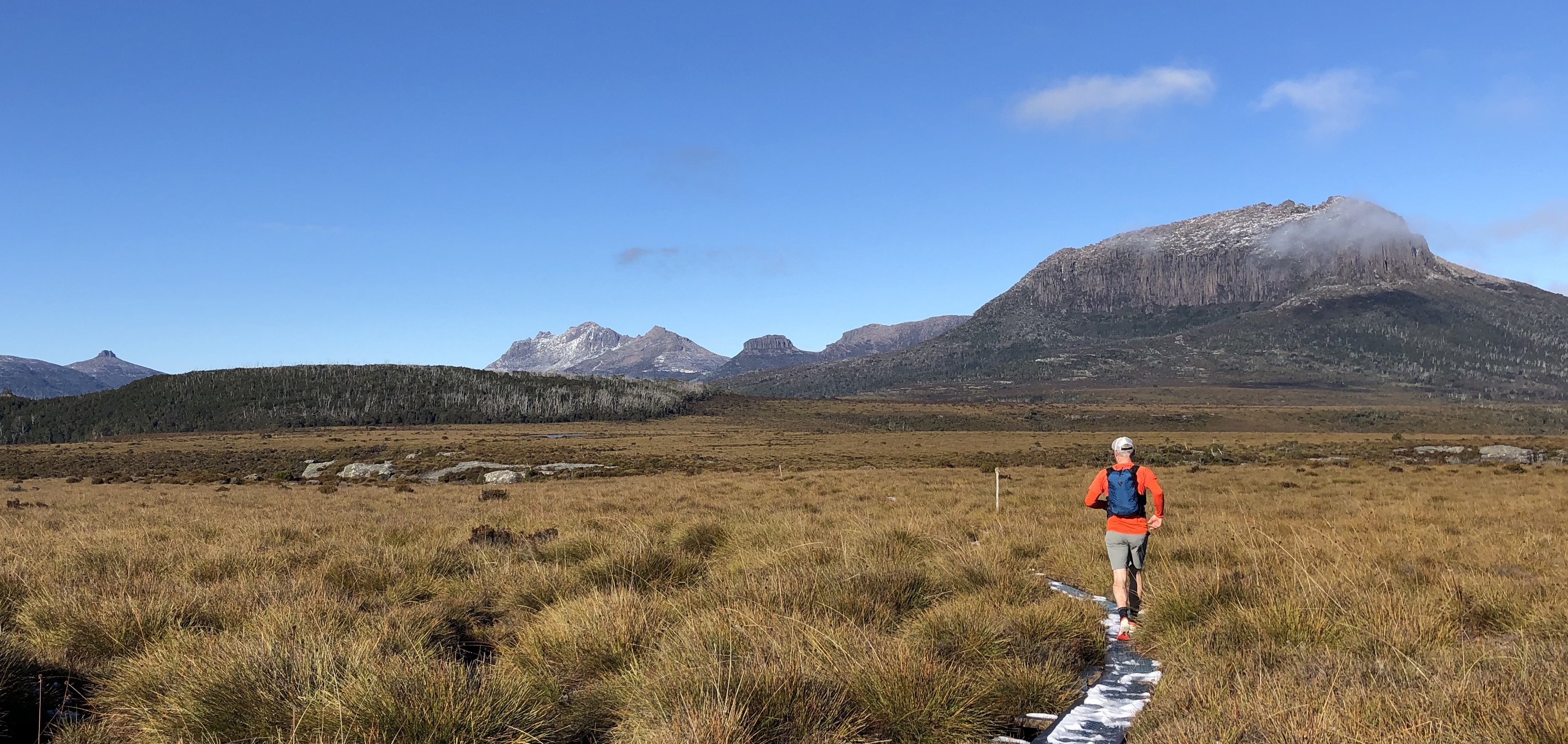
Trail running is a niche sport, and a lot of trail runners like it that way. But as more people are converted to the trails, we need a collective voice and pathway for development. A group of Tasmanian trail runners is taking a bottom-up approach to this, creating a state association they hope will empower athletes and lay the foundation for national representation. Story by Lauren Shay.
Tasmania’s wilderness is trail running at its best. Raw, gnarly and breathtakingly beautiful. You could even say Tassie is to Australia what Chamonix is to France in terms of pure trail–running awesomeness.
More people around Australia and the globe are heeding the call of Tasmania’s glorious trails and wild adventures. But there has been no collective body to ensure the sport grows in the state sustainably. There’s been no united voice to represent and empower runners, to protect and maintain the trails, ensure the state takes trail running seriously, and nurture athlete development.
That is, until now. The Tasmanian Trail Running Association (TTRA) strives to be the voice of the state’s trail running community. Following its inaugural AGM in early November, the executive committee includes president John Claridge, vice president Lincoln Quilliam, treasurer Leanne Evans and secretary Nick Campbell. Committee members are: Chris Price, Raylea Rowbottom, Neil Hawthorne, Matt Pearce, Bree Hunter, Carolyn Davis, Daniel Nunan, Kate Hiney, Aaron Leeman-Smith and Coby Gore.
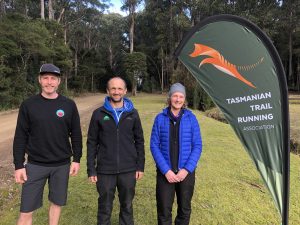
The association aims to connect, include, develop and empower runners and race organisers, and work with authorities so the sport – and the trails – can flourish. The TTRA will benefit not only local runners and organisers, but also visitors to the state and, indeed, the national trail-running scene.
I talked to John (Australia’s national representative to the International Trail Running Association – ITRA) and Lincoln (tarkine Ultra race director) about the TTRA, the benefits it will bring, and the implications it could have nationally and even globally.
Why does Tasmania need a trail running association?
John: About 10 years ago, I was heavily involved in the Australian Three Peaks Race as a runner representative on the committee (Three Peaks was a non-stop off–shore sailing and running event, starting at Beauty Point, near Launceston, and finishing on the Derwent River, Hobart). It dawned on me that trail running had no representative at all from a government point of view or a contact point of view. It needed a representative body. I decided to get some like-minded people on board, and Lincoln was one of the first people I talked to about what I wanted to achieve.
Lincoln: I returned to Tassie a couple of years ago after living on the mainland for a while, and was frothing on the trail running scene! Tassie is an absolute trail–running paradise. After starting the tarkine Ultra and talking to Johnno and others, it was clear that trail running in the state was struggling. It wasn’t getting traction with the authorities, and it wasn’t viewed as a serious sport. We needed to have a formal body to represent the sport in all its forms – from your recreational runners and events to crazy wilderness adventures, from athlete development to world championships, from race directors to tour operators. We aim to represent all forms of trail running in Tasmania, to be the voice. Mountain biking has done really well in Tasmania, but trail running is 10 to 20 years behind it in terms of organisation, representation and being factored into master planning.
John: We draw parallels with mountain biking all the time, and rightly so. If you look at the numbers, trail running is much, much bigger than mountain biking. But we have never had the same level of support. I feel pretty strongly that a lot of that is because mountain biking in Tasmania came about because of Cycling Australia. It found another niche it could develop. We don’t have that national or international body fighting for us. ITRA and the World Mountain Running Association have been around for a while, but we don’t have that body in Australia to say, “We’re this big, we’d like this sort of support.” So, we’ve reverse engineered it in a way. We thought, “Well if we’re not going to have the support on a national level, we need to start from a state level and put our foot forward.”
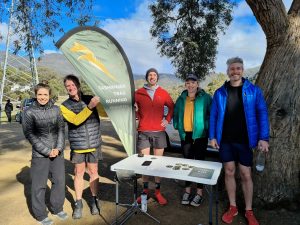
How do you think the Tasmanian authorities and general public perceive trail running? Do perceptions need to change?
John: In the past, there has been a big issue with trail running. There’s been the argument that we create a lot more damage and make more of an environmental impact than bushwalkers, but that’s simply not true. It’s not so much that we want to prove this to them; it’s more that we want to work with the authorities so they can understand where we’re coming from.
Lincoln: I see it as just a lack of familiarity and a level of comfort. Without an organisation representing trail running, it’s hard for people to become familiar with us. And the fact that the Australian Mountain Running Championships had just 70 people in total in 2017, that sort of number communicated to the authorities that, “Oh well, if the championships only get 70 people, it’s not a real sport.” But of course, that’s mountain running, not trail running – or you could argue it’s a form of trail running. You’re not going to get droves of people to a mountain–running event. So, it’s just about raising that level of awareness, so people don’t feel like they can just ignore us and we’ll go away. We all know trail running is booming and we want to work with Parks and Wildlife to avoid issues.
Parks staff see hundreds of underprepared bushwalkers get into trouble. So, when they see trail runners in the wilderness who aren’t carrying tents, they think, “Well, that’s just going to be a nightmare for them.” We understand why they’re concerned, but we’ve got as much right as bushwalkers to be on the tracks, and that’s why one of our first actions will be to put together a trail etiquette guide with minimum mandatory gear recommendations. We want to make safety a priority.
The health benefits of trail running are absolutely massive, too – obviously, the physical aspects, but also those mental health aspects you get with being immersed in nature and that sense of community. We want to really emphasise that.
What benefits will the TTRA bring to Tasmanian trail runners and runners who visit from interstate and abroad?
Lincoln: Access to all the permitted walks as runners is one thing we can’t solve immediately, but it is something we will work on. For example, during the permitted season, a runner is supposed to buy the full five-day bushwalking permit if they want to go on the Overland Track. Obviously, trail runners don’t make anywhere near as much impact as bushwalkers do. We are quicker and spend less time on the trail, and we certainly don’t stay in the huts, so the cost of the bushwalking permit doesn’t reflect the usage. Also, it’s not fair on the bushwalking community. We’re effectively given five days of use, but we’re only there for one day, so a runner’s permit would remove that capacity. We want to ensure the authorities understand what trail running is and how we are different from bushwalking and mountain biking.
We want to help race organisers, too. Starting a new race in Tassie is difficult. Often, a nominal permit limit of 100 runners gets slapped on any new event. For larger-scale runs, logistically, that’s not financially feasible. Again, it’s about building that familiarity and comfortability with Parks to enable Tassie to achieve its potential as a global trail-running destination. We’ve already got some amazing events, but others could be held.
John: Importantly, the association is not planning to do any events itself. I was very adamant – and the whole committee is, too – that we don’t have that conflict of interest by trying to run our own events. We want to provide a framework for visitors, competitors and organisers. Our aim is to create a small leaflet, like a trail etiquette guide, that can be handed to tourist runners for when they enter our wildlife areas. And that goes for organisers, as well. We’d like to keep a professionalism in the sport and our events around the state.
Lincoln: Certainly, we are not giving trail-running events or runners a bad name. We just want to provide a kind of code of conduct. Of course, it will tap into leave–no–trace principles and talk about respecting other trail users, like mountain bikers and bushwalkers, and how we need to take care of ourselves in terms of safety. Because we runners can go further into the wilderness and don’t carry tents, we need to make sure people are aware of the safety and survival gear they should take for different seasons and, importantly, know how to use it.
Another point is that Tassie has a lack of resources to maintain tracks to an appropriate level. The volunteer systems are there, but they aren’t necessarily the easiest to work through. We’ve had a group of 20 trail runners keen to trim tracks at the back of Mt Wellington. There have been three rescues on that track within a period of six months due to lack of navigational markers and an overgrown track. We’ve had these people raring to get out there and get it done for the last 10 months, but it hasn’t happened yet, mainly due to COVID. So, that’s another key thing we want to do – connect with the trail runners who are keen to maintain the tracks on a volunteer basis. We’ve got amazing landscapes, but unless the trails are reasonably maintained, you’re just bush bashing the whole time, and the experience won’t be that great.
John: It goes hand in hand with being proactive with Parks and letting them know we want to help them. We want to have a good working relationship with them.
Lincoln: Moving forward, we’ll also be present and visible at trail running events in Tassie, engaging with our community on a face-to–face basis, adhering to COVID-19 guidelines of course, so that we can understand our community and they can get a feel for what we do. The more communication, the better, so that our entire trail–running community will feel adequately represented.
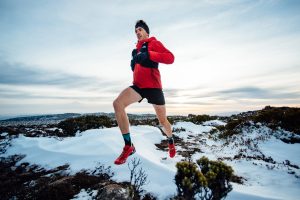
Do you think trail running in Australia lacks opportunities for athlete development? Will this be a priority for TTRA?
John: The one thing that defines sport in most people’s eyes is that pathway from grassroots to elite-level athletes. Our athletes are amongst the best in the world, but if you mention Kilian Jornet or Emelie Forsberg, most people don’t have a clue who they are because trail running is not a mainstream sport. There’s no framework for it, either. For example, I won all my cross countries at high school, but I was never picked up for athletics because I never did track and field. I was a state marathon champion, but I was always on the trails. I would like to see the next generation have that framework set up for them.
Lincoln: We definitely want to get into schools to make sure kids know what trail running is and the benefits it holds. We don’t want to compete with cross country as such, but we want to work with schools to figure out how trail running fits and where the value is. That will be a longer-term objective.
What does the future look like for trail running in Tasmania?
John: Awesome!
Lincoln: Personally, I think Tassie could be a global destination for trail running, but it’s not just about visitors, it’s more about Tasmanians getting out there and enjoying our wild places. There are, of course, plenty of trail runners already out there enjoying our backyard, but trail running is still not quite as mainstream as it is in Chamonix or Queenstown in New Zealand, or other places that have mountains on their doorstep. We do have a strong local community and a healthy suite of well-respected and well–run events and tours. But we’ve got so much more opportunity and potential as well.
For more information on the TTRA or to get in touch, visit www.facebook.com/T.T.R.asn
TTRA EXEC Q&A
John Claridge
Position: President
Age: 40
Location: Gravelly Beach, Northern Tasmania
Other roles in trail running: ITRA Australian organisers representative, owner and founder of Ultrain, event director Triple Top Mountain Run
What trail running means to you: Trail running is my centre and source. It is the only non–human entity in my life that gives me perspective and the drive to do all that I do. I believe we all need some sort of contact and connection to our natural environment, and trail running allows me to do this with a further reach into truly wild places.
Favourite Tassie trail: Tasmania is one spectacular trail network! But if I had to narrow it down to three, Arm River to Mt Oakleigh (purely breathtaking views), Greens Beach to Spring Lawn (amazing coastal run) and Oura Oura – Tassie’s best VKM!
Best moment on the trail: Finishing my 10th Australian in the Three Peaks Race or watching my partner win UTA 100 in 2019.
Worst moment on the trail: Being the race director at the event for Leanne’s worst moment! And the resultant six months of injuries for the friend who tripped.
Trail snack of choice: Honey sanga and Clif Bars.
Favourite sock colour: Black and blue.
Lincoln Quilliam
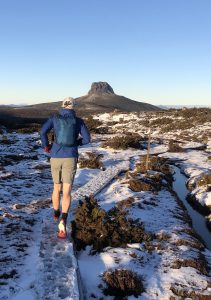 Position: Vice president
Position: Vice president
Age: 39
Location: Hobart / nipaluna
Other roles in trail running: Creator and race director of takayna Ultra, co-leader of Hobart Trail Runners, track maintenance contractor and volunteer, wilderness adventure run frother!
What trail running means to you: Solstice in nature and the most effective means of getting out in the bush/wilderness with legends to tackle epic challenges.
Favourite Tassie trail: Tough, as there are so many awesome adventures out there and many I am yet to run on! Three Capes Track is a highlight for runability (the highest quality multi-day track in Tassie), some of the world’s best sea cliff landscapes, a fun and solid day for distance and elevation, best year–round weather, and friendly parks rangers with nice, fresh rainwater at the huts.
Best moment on the trail: In the snow on kunanyi / Mt Wellington on Hobart’s doorstep with legends who also froth on running in the snow! Neoprene socks and calf protection also help.
Worst moment on the trail: Missing the aid station at the event base at the Hounslow Classic (der… just look, right!?), hence no water for two hours and the dehydration setting in on the 1,000m climb in the midday sun …
Trail snack of choice: Homemade Anzac biscuits.
Favourite sock colour: Black.
Leanne Evans
Position: Treasurer
Age: 49
Location: Launceston
Other roles in trail running: Event director and founder of Kate Reed parkrun (trail).
What trail running means to you: Trail running is my escape from the busyness of life. It keeps me grounded and provides the perfect opportunity to experience nature and the wilderness solo or with a group of like–minded people.
Favourite Tassie trail: This is a tough one. There are so many awesome trails in Tassie, a number of which I am yet to experience. I love mountains with a good climb to an amazing outlook, but we also have some amazing coastal trails. The Walls of Jerusalem would definitely be up there as a fav, as is the South Coast Trail.
Best moment on the trail: I can’t pinpoint a single best moment, as I can recall so many. There is something special about coming across native wildlife. Additionally, some of the views and scenery I have experienced have been sensational.
Worst moment on the trail: Running a local event and coming across a friend who had tripped and hit her head, resulting in a concussion. Several of us carried her out on a makeshift stretcher to the waiting ambulance.
Trail snack of choice: Salted, steamed potato or, for a sugar fix, black jellybeans.
Favourite sock colour: Patterned.
Nick Campbell
Position: Secretary
Age: 33
Location: Hobart / nipaluna
What trail running means to you: My chance to escape in nature and maintain physical and mental fitness while appreciating my surroundings.
Favourite Tassie trail: Waterfall Bay/Bluff, Tasman Peninsula.
Best moment on the trail: Spotting echidnas and platypus on kunanyi.
Worst moment on the trail: Rolling my ankle at night on the trails mid–race at Trevallyn.
Trail snack of choice: Jelly snakes and chocolate brownies.
Favourite sock colour: Bright pink.




